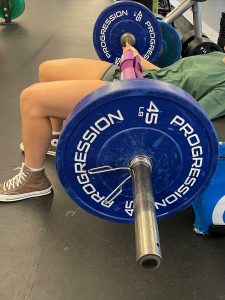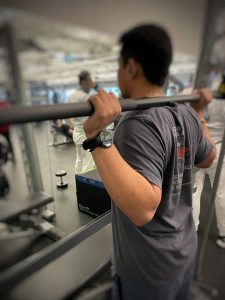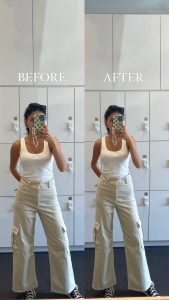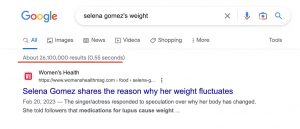
Tina Behin
Tina is currently completing her Bachelor of Arts with a major in Psychology at Capilano University. She received recognition for making the Dean’s list in two consecutive semesters and for demonstrating academic achievement throughout her full course of studies. Tina intends to continue her education at UBC to earn a Masters of Psychology. Her future plans call for her to pursue psychology with the intention of becoming a therapist.
I closed my eyes, inhaled slowly, and took that step. I counted to three in my mind, exhaled, and opened my eyes before gazing down. One hundred and thirteen. That should be an appropriate weight for a thirteen-year-old girl my height, but for some reason, when I saw those numbers, it did not sit right with me. The change in mindset seemed to have taken place suddenly. I woke up one morning, looked at myself in the mirror and saw a different version of myself. Everything appeared larger and disproportionate. The scale read the same numbers as the night before, but the girl in the mirror looked different. I kept looking at myself, wondering if I had always looked that way. If so, why had I noticed it so suddenly?
I remember beginning to truly draw attention to my appearance, staring at the mirror endlessly and identifying numerous flaws. Slowly I had lost count of the number of flaws I saw and simply started becoming fixated on everything. Depriving myself of my favorite foods and going for nightly runs seemed to be the only option at the time. Despite the fact that the numbers on the scale kept declining with every new time I checked, I was still unable to detect any changes within my own reflection. If anything, I thought that I looked bigger. Gradually, going on the scale after every meal became a routine to me. I wanted to resemble the other girls my age that I had been seeing on social media, and the voice in my head kept telling me to run faster. So I did.
One hundred and ten. The faster I would run, the heavier my heart had felt. One night after my run, I went on the scale, just to see if the number was smaller than before. And it did. The scale indicated a lower number than the last time I checked but after I had checked the mirror, I got even more discouraged. The person in the mirror appeared even more out of proportion. I remember thinking that it could not be me. So I had decided to skip my meal and go to bed.
It had become a routine for me to hop on the scale after my meals and continuously check the mirror to see how bloated I looked throughout the day. This new obsession with my appearance was slowly taking over my life. I stopped wearing certain clothing, I could not leave the house without applying heavy piles of makeup on my face, and I stopped enjoying my love for food. What was once a healthy and bright 13-year-old girl slowly had become a shy, self-conscious, and sad teenager.
One hundred and seven. When I was 14 years old, I began looking up the weight of my favourite celebrities. Even though I knew better, I could not help but be intrigued. Rushing home after school to look up someone’s weight should not be on a 14-year old’s mind, but at the time it was all I cared about. If you search “Selena Gomez’s weight” on Google, there are over 26,100,000 results in 0.55 seconds. It had taken me half of a second to find out that Selena Gomez, someone who was 19 years old at the time, and three inches shorter than me, weighed 100 pounds. It was as if I had a tunnel vision, and only saw the number of pounds she weighed, completely disregarding the statistics. I had cried myself to sleep that night.
This is a screenshot of how long it took me to find out Selena Gomez’s weight on google.
I was never this self-conscious before high school. I was always confident, outgoing, carefree. But seeing images of teenage models or celebrities who were also in their teenage years getting praised for their petite and ‘flawless’ physique, it was hard to not compare bodies. I remember thinking to myself whether this vicious cycle of comparison would ever stop. Would I ever go back to loving myself for who I was?
While social media was widely used prior to COVID-19, teenagers all over the world started spending an alarmingly greater amount of time on social media during the pandemic. Teenagers started spending more hours browsing through their phones at home as a result of having more free time and being constrained during the lockdown. The frequency of eating disorders increased globally from 3.4% to 7.8% as more time was spent scrolling through the media (Sing Care Team, 2023). As to be expected, 94% of adolescents in developed countries now use platforms such as Instagram and TikTok daily (Steinsbekk et al., 2021). Social media use is linked to self-objectification and unhealthy body comparisons, and even just 30 minutes a day on the platform can change how you perceive your own body (Fardouly & Vartanian, 2015).
Teenagers who frequently use social media generally have lower levels of self-esteem, which leads to an increase in social comparisons (Acar et al., 2022). When individuals compare themselves to photos or videos they see online, they frequently overlook the fact that the majority of the content has been edited, contains filters, or that people typically post their most “attractive” pictures. These adolescents are more likely to later develop complications like eating disorders, depression, and poor self-esteem as a result of their body dissatisfaction (Gowers & Shore, 2001).
One of the most common forms of self-employed therapy that teenagers encounter for eating disorders and weight issues is maladaptive exercise, which refers to the desire to engage in compulsive physical activity to control one’s weight or shape (Gorrell et al., 2021). This compulsive behavior, however, has the potential to greatly increase the risk of engaging in suicidal behavior, worsen outcomes of therapy, contribute to eating disorders, and ultimately to intensify related psychopathology (Gorrell et al., 2021). Given how vulnerable adolescents are, seeing these images and videos when they are young can have a seriously negative effect on their wellbeing. (Fardouly et al., 2020). Youth must therefore be able to tell what has been edited to get notice online compared to what is real.
The first person I interviewed, Emily, who wished to change her name, began using social media at 13 years old and continues to be an active user today at 24. Emily, who has long black hair, an olive complexion, brown eyes, and a curvy figure, is of Persian descent. She has always been the opposite of the Western standards of beauty, which include being tall and thin, with lighter skin, a small nose, and coloured eyes. Throughout her adolescence, Emily would compare herself to Instagram and Victoria Secret models in the media, all of whom are primarily white and thin. After seeing those pictures a few times and contrasting her dark ethnic features with the models, she started to lose confidence in herself and began to dislike how she looked.

A photo of Emily on leg day. She goes to the gym regularly now.
Because of the images of those allegedly “flawless” people she had seen online, Emily felt the need to use an editing tool to hide her imperfections before sharing them to her social media accounts. She remembered frequently crying as a 13-year-old, due to her dissatisfaction with her background and looks. Emily had in the past drastically changed photographs to enlarge her hips, reduce her waist, and lighten her complexion in an effort to appear more Westernized. She had chosen not to share the photos, however, because they depicted a person she desired to be, but clearly was not.
By the age of 13, 80% of females have downloaded an app or used a filter to alter their appearance in photos (Dove, 2021). Hyper-realistic AI filters have gained popularity as a way to alter someone’s appearance, with the majority of them making people appear more Westernized. These beauty filters are easily available for people through apps like TikTok and Instagram, and they promote unattainable beauty standards. The filters that enlarge eyes, smoothen skin, lighten skin tone, whiten teeth, and make people appear slimmer are the most used ones, and 94% of those who use filters claim to feel pressured to look a certain way (Dr. Well, 2023).
People today frequently use filters to improve the look of their photos and videos, however once the filter is removed, their self-esteem decreases. “Normally, we compare ourselves to other humans, but with filters, you’re comparing yourself to another version of you, which is almost more devastating because it carries the seed of suggestion that that could be you,” says Renee Engeln, Ph.D., a professor of psychology at Northwestern University (Sullivan, 2023). Social media has promoted an unrealistic perception of beauty in people all over the world through the use of these filters to generate an artificial reality, which has resulted in interpersonal challenges and a decrease in one’s sense of self-worth.
I have occasionally felt tempted to post a photo of myself that has been heavily edited. It can be challenging to understand that, as a woman of color, you will always be underrepresented and that you will never meet the Western beauty standards that rule the social world. It can therefore be challenging to resist using a tool that can alter the way you look and eventually make you feel like you fit in. When deciding to share a story on my Instagram, I have used filters numerous times, almost always selecting the “beauty filter.” Every time I applied filters to my content, I inadvertently began to believe that I had to appear just as pretty and flawless in real life. It was as if I began to resent the real-life version of myself in the mirror while adoring the AI version of myself on my phone. The use of a tool that can change the way you look and make you feel like you ultimately fit in can therefore be difficult to resist. Dr. Tara Well, an associate professor of psychology at Barnard College of Columbia University describes how the use of filters to manipulate our appearances engages in self-objectification, “It’s the idea that you see yourself as a physical object that you’re trying to improve and make perfect” (Sullivan, 2023).
Emily also recalled how, as a teenager, she gave up playing volleyball, a sport she had enjoyed and engaged in since elementary school. When she first began high school, she recalled reading articles about supermodel Gigi Hadid playing volleyball. As she quickly read through the narratives, she came across several offensive words. She was uncomfortable with how the media had sexualized the sport and, as any adolescent girl would, she started comparing her own body to Gigi’s. Soon after, she stopped playing volleyball because looking at those photos and reading through the articles made her feel unworthy of being on the team, despite her ability as a player. She allowed these intrusive thoughts to interfere with her love for the game. She claims she still regrets her decision to walk away from volleyball.
By the age of 14, females quit playing sports at a rate that is twice as high as that of boys (Sabo & Veliz, 2008). When it comes to sports, gender equality is not widespread and frequently, stereotypical, sexualized, and sexist depictions of sportswomen are made in the media (MacPherson & Kerr, 2020). Their athletic ability receives less media coverage than their physical features or femininity, and the over-sexualization of female representation is pervasive, manifesting in language, appearance, and socially created expectations (MacPherson & Kerr, 2020). Disordered eating affects 62% of female athletes, and those who battle with disordered eating are eight times more likely to be injured (Bothwell, 2021). As previously stated, social media has a significant influence, so when these athletes see the socially constructed standards in the media, they start to accept them.
Emily responded to the question of whether social media continues to affect her body image by saying “back then, I was [a] very sad [teenage girl]. I did not like the way I looked, and for many years I was unhappy with my appearance. [But] now I am a lot more confident and [pleased] with my appearance. I rarely [use filters] or compare myself to online media since I have learned to love my body for what it is.” As they are mindful of how an AI filter alters how they appear, adults are less likely to be triggered or influenced by these filters (Sullivan, 2023).
Male and female comparisons have been a central theme in a number of studies on bodily satisfaction and social media. Even though it was intriguing, I was interested in finding more studies that concentrated on men. I was surprised however, by how challenging it was to do so and by the fact that most of the articles concentrated exclusively on young and adult females. Males have been found to have more positive social media experiences since a lot of them do not seem to be affected by the media at all (Ricciardelli et al., 2000). This difference in perception could be due to how public criticism of men’s weight and body type is less prevalent than that of women. As a result, they do not hold themselves to the same norms as women do. Many males claim that viewing images of muscular or lean men in the media promotes a favourable viewpoint on body satisfaction (Ricciardelli et al., 2000), which is similar to my conversation with the second participant.
Josh, who also wished to change his name, began using social media at 13 years old and continues to be an active user. He is a 23-year-old Hispanic male who claimed to view social media as a harmful instrument for youth, especially females. According to Josh, masculine beauty ideals are more attainable than female beauty norms. He was convinced that a lean, muscular physique—the so-called “ideal” body type for men—could be attained through dedication and hard work. Josh “strongly believed that the beauty standards [set] for women are a lot harder to achieve because they are [more] unrealistic.”

A photo of Josh working out.
In response to the question on whether he believes that social media has an impact on his body image, he said, “If I see someone online and am ‘influenced’ by their appearance, it is in a motivational sense [rather] than a comparative one.” He continued by saying that if he were a woman in today’s society, he would constantly be comparing himself to different people because of the unrealistic beauty standards that are portrayed. However, he personally has never felt pressured by the media or his peers to compare himself or achieve a particular appearance.
He continued by saying how he has always been a self-assured individual, taking part in extracurricular activities in high school, going to parties, and dressing however he liked. When asked if he was happy with his body, his confident answer of “absolutely” made me wonder why women do not have the same experience.
Although their circumstances may vary from those of the two students I spoke with, some people are unable to recover from the effects of media exposure. The most prevalent environmental factor influencing the development of eating disorders is society’s idealization of thinness. Individuals with eating disorders frequently suffer from co-occurring illnesses as well, which can have a lifelong impact on them (Steinsbekk et al., 2021). Alcoholism, drug addiction, ADHD, OCD, PTSD, depression, and other mental health conditions frequently coexist with eating disorders (Statistics & Research on Eating Disorders, 2021). Despite the fact that eating disorders are among the most dangerous psychiatric problems, a number of individuals still seek treatment in an effort to get better; yet, only around 40% of youth who complete therapy have full recovery from these types of disorders (Gorrell et al., 2021). And about one person per hour dies as a direct consequence of an eating disorder (Sing Care Team, 2023).
There are clear gender inequalities in teenage social media use, leaving women primarily responsible for the detrimental impacts, according to these two interviews as well as several studies. In contrast to the female student, who talked extensively about negative events during the interview, the male student could only give brief responses. Although uncommon, it is possible for some individuals to have no impact from social media. Nevertheless, this disparity in experience could be related to the fact that some groups are more specifically targeted than others, as well as the quantity of time spent online. The easier a schema is to access in memory, the more likely it is to be used to guide decisions and behaviors (Ward & Grower, 2020). Thus, it has been suggested that exposure to gender stereotypes in the media on a regular basis might lead to stereotypical gender schemas, which can then affect future judgments and lifestyles (Ward & Grower, 2020).

This is a photo of my family and I on graduation day. When this photo was taken, I thought that I looked “too big” and that my stomach was showing too much. It is when I was at my lowest weight.
There are some approaches I have learned about that can be used to combat media-induced body dissatisfaction, while cultivating a more positive relationship with social media. To begin, users must realize that most internet photographs are manipulated and do not accurately portray how people appear in real life. In truth, a lot of the celebrities that young people look up to have cosmetic surgery, but by keeping it a secret, they mislead the public about what real, unaltered beauty looks like. Reducing social media use has been demonstrated to significantly enhance how adolescents and young adults depict their general appearance and body weight (Thai et al., 2023). Therefore, cutting back on social media use or even taking an extended break from it may be beneficial.
Because young individuals who are dissatisfied with their appearance are more likely to engage in risky and harmful behaviours (Bornioli, 2019), it is critical that the government devise a solution to filter the content that these preadolescents and teenagers see online. In addition, further research into the possibility of media literacy efforts to assist youth in combating media stereotypes is also required. Implementing a media literacy curriculum in schools will encourage informed community involvement and make youth more aware of the risks associated with social media, since critical media literacy provides individuals with the knowledge necessary to critically assess media in all of its forms (Joanou, 2017; Mclean et al., 2017).
More than half of preadolescents use social media, despite being younger than the platform’s minimum age limit, indicating how pervasive social media has become in attracting users from a young age (Fardouly et al., 2020). Preadolescence is a delicate developmental stage where children are still building their identities and are susceptible to outside influences. Thus, the impact of social media can be amplified at this time due of their fragile states (Fardouly et al., 2020). Similar to how there is a gender divide in numerous areas, social media use has been designed to target more females than males. Men seemingly have the freedom to choose to overlook the negative aspects of using social media, whereas women are forced to cope with these challenges.

A comparison of my old photo editing techniques. Although I would not share the edited photos, looking at these Photoshopped images would motivate me to lose weight.
For me, everything began one hundred and thirteen. Since body dysmorphia is more of a mental fight than a numerical issue, any number may have set off my condition. Even when the weight came in at 110, I did not feel good about myself. I became broken as a teen growing up in the digital age and I felt increasingly inferior because of it — I did not measure up. Given how pervasive social media use is on a global scale and how crucial it has become to adolescent life and development (Jarman et al., 2021), what will happen to the teenagers of today?
Social media is being used by society for peer assessment and acceptance, which can be extremely damaging to one’s self-esteem (Acar et al., 2022). Teenagers who regularly use social media as well as those who grew up in the digital age are more prone to experience body dissatisfaction and, as a result, alter their look. Thus, it is imperative that parents monitor their kids’ social media usage and that social media platforms like Instagram and TikTok tighten their controls over what can be shared online. In order to promote a less disturbing and more welcoming environment, platforms themselves should get rid of challenges, trends, and hashtags like “thinspo” that reinforce eating disorder cultures. Similar to the two students I interviewed, some teenagers overcome these obstacles as they mature, but for others, like myself, it is still a constant struggle.
References
Acar, I. H., Avcılar, G., Yazıcı, G., & Bostancı, S. (2022). The roles of adolescents’ emotional
problems and social media addiction on their self-esteem. Current Psychology: A Journal
for Diverse Perspectives on Diverse Psychological Issues, 41(10), 6838–6847.
https://doi.org/10.1007/s12144-020-01174-5
Bornioli, A., Lewis-Smith, H., Smith, A., Slater, A., & Bray, I. (2019). Adolescent body
dissatisfaction and disordered eating: Predictors of later risky health behaviours. Social
Science & Medicine, 238.
https://doi-org.ezproxy.capilanou.ca/10.1016/j.socscimed.2019.112458
Bothwell, S. (2021). What athletes are most likely to have an eating disorder.
Eating Disorder Hope. Retrieved from https://www.eatingdisorderhope.com/blog/what-athletes-are-most-likely-to-have-an-eating-disorder#:~:text=Athletes%20%26%20Eating%20Disorder%20Statistics&text=Disordered%20eating%20impacts%2062%25%20of,%25%20of%20male%20athletes%20%5B1%5D
Dove. (2021). 5 tips to have a healthy relationship with social media. Dove US. Retrieved from
https://www.dove.com/us/en/stories/about-dove/social-media-tips.html
Dr. Well, T. (2023). The hidden danger of online beauty filters. Psychology Today.
Retrieved from https://www.psychologytoday.com/ca/blog/the-clarity/202303/can-beauty-filters-damage-your-self-esteem#:~:text=Other%20research%20finds%20that%20young,and%20behaviors%20start%20quite%20early.
Fardouly, J., Magson, N. R., Rapee, R. M., Johnco, C. J., & Oar, E. L. (2020). The use of social
media by Australian preadolescents and its links with mental health. Journal of Clinical
Psychology, 76(7), 1304–1326. https://doi-org.ezproxy.capilanou.ca/10.1002/jclp.22936
Fardouly, J., & Vartanian, L. R. (2015). Negative comparisons about one’s appearance mediate
the relationship between Facebook usage and body image concerns. Body Image, 12, 82–
- https://doi-org.ezproxy.capilanou.ca/10.1016/j.bodyim.2014.10.004
Gorrell, S., Flatt, R. E., Bulik, C. M., & Le Grange, D. (2021). Psychosocial etiology of
maladaptive exercise and its role in eating disorders: A systematic review. International
Journal of Eating Disorders, 54(8), 1358–1376. https://doi-
org.ezproxy.capilanou.ca/10.1002/eat.23524
Gowers, S. G., & Shore, A. (2001). Development of weight and shape concerns in the aetiology
of eating disorders. The British Journal of Psychiatry, 179(3), 236–242.
https://doi.org/10.1192/bjp.179.3.236
Jarman, H. K., Marques, M. D., McLean, S. A., Slater, A., & Paxton, S. J. (2021). Social media,
body satisfaction and well-being among adolescents: A mediation model of appearance-
ideal internalization and comparison. Body Image, 36, 139–148.
https://doi.org/10.1016/j.bodyim.2020.11.005
Joanou, J. P. (2017). Examining the World Around Us: Critical Media Literacy in Teacher
Education. Multicultural Perspectives, 19(1), 40–46. https://doi-org.ezproxy.capilanou.ca/10.1080/15210960.2017.1267514
MacPherson, E., & Kerr, G. (2020). Online public shaming of professional athletes: Gender
matters. Psychology of Sport and Exercise, 51. https://doi-
org.ezproxy.capilanou.ca/10.1016/j.psychsport.2020.101782
McLean, S. A., Wertheim, E. H., Masters, J., & Paxton, S. J. (2017). A pilot evaluation of a
social media literacy intervention to reduce risk factors for eating disorders. International
Journal of Eating Disorders, 50(7), 847–851. https://doi-org.ezproxy.capilanou.ca/10.1002/eat.22708
Ricciardelli, L. A., McCabe, M. P., & Banfield, S. (2000). Body image and body change
methods in adolescent boys: Role of parents, friends, and the media. Journal of
Psychosomatic Research, 49(3), 189–197. https://doi.org/10.1016/S0022-3999(00)00159-
8
Sabo, D., & Veliz, P. (2008). Go out and play: Youth sports in America. Women’s
Sports Foundation. Retrieved from https://files.eric.ed.gov/fulltext/ED539976.pdf
Single Care Team. (2023). Eating disorder statistics in the U.S. in 2020. The
Checkup. Retrieved from https://www.singlecare.com/blog/news/eating-disorder-statistics/
Statistics & Research on Eating Disorders. National Eating Disorders Association. (2021, July
14). Retrieved from https://www.nationaleatingdisorders.org/statistics-research-eating-disorders
Steinsbekk, S., Wichstrøm, L., Stenseng, F., Nesi, J., Hygen, B. W., & Skalická, V. (2021). The
impact of social media use on appearance self-esteem from childhood to adolescence—A
3-wave community study. Computers in Human Behavior, 114. https://doi- org.ezproxy.capilanou.ca/10.1016/j.chb.2020.106528
Sullivan, J. G. (2023). Are beauty filters actually that bad for my mental health? The
Cut. Retrieved from https://www.thecut.com/article/are-beauty-filters-actually-that-bad-for-my-mental-health.html
Thai, H., Davis, C. G., Mahboob, W., Perry, S., Adams, A., & Goldfield, G. S. (2023). Reducing
social media use improves appearance and weight esteem in youth with emotional distress. Psychology of Popular Media. https://doi-org.ezproxy.capilanou.ca/10.1037/ppm0000460
Ward, M. L., & Grower, P. (2020). Media and the development of gender role
stereotypes. Annual Review of Developmental Psychology. Retrieved from
https://www.annualreviews.org/doi/10.1146/annurev-devpsych-051120-010630
